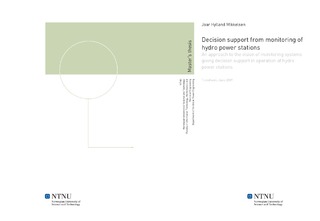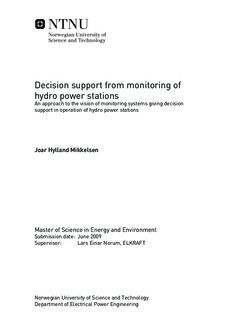| dc.contributor.advisor | Norum, Lars Einar | nb_NO |
| dc.contributor.author | Mikkelsen, Joar Hylland | nb_NO |
| dc.date.accessioned | 2014-12-19T13:51:23Z | |
| dc.date.available | 2014-12-19T13:51:23Z | |
| dc.date.created | 2010-09-04 | nb_NO |
| dc.date.issued | 2009 | nb_NO |
| dc.identifier | 348837 | nb_NO |
| dc.identifier | ntnudaim:4824 | nb_NO |
| dc.identifier.uri | http://hdl.handle.net/11250/256630 | |
| dc.description.abstract | This report is the results of the work on a master thesis concerning intelligent monitoring of hydro power stations. In the report two different types of computer software is investigated to find out whether they are suitable to make out a monitoring system capable of giving the user information about faults and unwanted operating conditions at an early stage. It is also investigated whether the software has proven the capability to detect faults and unwanted operating conditions. The different advantages and disadvantages of the two software products are commented and the two software products are compared. This report shows that the two software products are quite different. The software from Volve is software meant to construct an expert system capable of recognising faults from previous cases of faults. The software from SKF is software that gives intelligent machine diagnostics from analysis of vibration measurements in addition to measuring and trending of other variables. It also gives the user tools for analysing the root cause of faults influencing the bearing system of different industry machinery. This means that the software from SKF demands some involvement from the user to produce the best and most precise results. The expert system developed from the Volve software on the other hand is meant to present only results and advice to the user. The results from tests and simulations of the expert system developed by the Volve software are very limited. It is not possible to conclude which of the two software products is better before more tests of the Volve system is performed. In addition to the investigation of these two monitoring software products two different types of sensors are investigated. The sensors that are investigated are smoke sensors and sensors for detection of ultrasonic sound. Both types are commonly used in monitoring of industry processes similar to those in hydro power stations. These two sensors are capable of giving additional information to the monitoring system making it possible to detect faults that it is difficult to detect today. This is because the two sensor types perform measurements that the normal measuring equipment of today is incapable of. This will increase the information flow to the monitoring systems of hydro power stations making it possible to perform better and more precise monitoring. | nb_NO |
| dc.language | eng | nb_NO |
| dc.publisher | Institutt for elkraftteknikk | nb_NO |
| dc.subject | ntnudaim | no_NO |
| dc.subject | SIE5 energi og miljø | no_NO |
| dc.subject | Energibruk og energiplanlegging | no_NO |
| dc.title | Decision support from monitoring of hydro power stations: An approach to the vision of monitoring systems giving decision support in operation of hydro power stations | nb_NO |
| dc.type | Master thesis | nb_NO |
| dc.source.pagenumber | 60 | nb_NO |
| dc.contributor.department | Norges teknisk-naturvitenskapelige universitet, Fakultet for informasjonsteknologi, matematikk og elektroteknikk, Institutt for elkraftteknikk | nb_NO |

